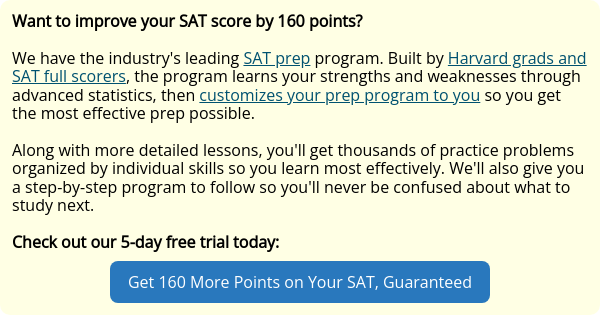
Function questions (also sometimes known as “meaning in context” questions) make up 17% of all passage-based reading questions, or about 12% of all SAT Critical Reading questions (based on my survey of the four publicly available post-2005 SATs). Answering function questions requires the ability to step back from the text and judge the effect of a phrase in a certain place (as opposed to little picture and vocab in context questions, which are just concerned with meaning).
So how are function questions asked on the SAT, and what strategies can you use to answer them? Read on to find out.
NOTE: Since the rollout of the digital SAT in 2023, function questions are no longer included on SAT Reading and Writing, although the new "text structure and purpose" questions are very similar. Learn about those and the ten other question types you'll see on SAT Reading and Writing.
Feature image credit: What's Your Function In Life? by bixentro, used under CC BY 2.0/Cropped from original.
What Are Function Questions?
Function questions ask what a phrase, sentence, paragraph does in the context of a passage. They are often framed as “The author wrote [this thing] in order to..."
Answering these questions can be tricky, because the wording of function questions often makes it seem as if they're asking “Why did the author do this thing?” Invariably, unless you are the author, your first response will probably be along the lines of "How should I know? I can't read the author's mind!"A better way to approach function questions is to rephrase them from "The author uses the phrase "The Great Old Ones" multiple times in order to..." to something more like “What effect does mentioning "The Old Ones" multiple times have in the context of [the lines, paragraph, or passage]?”
A label sometimes given to function questions is "meaning in context" questions, which I find to be a little too imprecise: the questions are asking about the EFFECT of a phrase in context, not what the phrase means (which would be an inference question). Let's say that I lived in a city that got over 100 inches of snow last winter, and just as I finished clearing snow out of the gutters, it started snowing again, prompting me to sing (sarcastically) "It's the most wonderful time of the year" as I smiled through gritted teeth. The MEANING of the words "most wonderful" in this context would be "worst" (as in "It's the worst time of the year"); the FUNCTION of the words "most wonderful" would be "to suggest that the speaker actually feels the opposite is true."
Just as with primary purpose questions, function questions usually have answer choices that are in the form of “verb a noun” (as in "add gravitas to the mythology" or "convey the passing of time"); the main difference between the two is that function questions ask about relatively small amounts of text (phrases or lines), as opposed to the entire paragraphs covered in big picture questions. In fact, having a good understanding of the big picture/main point of a passage can often assist you in answering function questions.
Consider this example: you're asked "The phrase “the life-or-death cycle of espionage and counterespionage” primarily serves to..." If you know that the main point is, for instance, about deep sea life, you’re unlikely to assume the phrase “the life-or-death cycle of espionage and counterespionage” promotes the idea that all underwater creatures are potential spies for other countries. Instead, it's far more likely that the function of the statement is to support the idea that in dangerous environments like the deep ocean, species are constantly evolving to win the fight for survival.
Here are a few examples of the most common ways you’ll see function questions presented in the SAT (adapted from actual SAT questions):
- “The primary purpose of the statements in lines 36-42 (“Like…from the deep”) is to…”
- “In lines 58-73, the description of the ocean floor primarily serves to…”
- “The author invokes “Cthulhu the destroyer” chiefly in order to…”
- “The author uses spy imagery in lines 84-85 in order to…”
- “Jun asks the questions in lines 41-42 (“Does…frightening”) primarily in order to…”
- “In lines 27-30, the author uses the word “ordinary” several times in order to”
 Ph'nglui mglw'nafh Cthulhu R'lyeh wgah'nagl fhtagn by Thomas Claveirole, used under CC BY-SA 2.0/Cropped from original.
Ph'nglui mglw'nafh Cthulhu R'lyeh wgah'nagl fhtagn by Thomas Claveirole, used under CC BY-SA 2.0/Cropped from original.
This is not in any way to imply that there is something lurking beneath the surface of the water. Why would you even think such a thing?
The Best Strategies for Answering Function Questions
Below, I’ve gathered the advice that is most helpful for answering function questions. Some of this advice is specific to certain ways of reading the passage (for instance, advice for students who read the whole passage before answering questions may be different from advice for students who read the questions before looking at the passage), while some advice is useful for everyone.
Understand What the Question Is Really Asking
I believe that this is the single most important part of consistently answering function questions correctly. The fact that function questions are worded in a way that makes it seem like you need to read the mind of the author (or character) can make these questions seem impenetrable. To some extent, I understand why the College Board words SAT Reading function questions the way it does. Questions that say “What does the mentioning of two sports stars do” are too open to interpretation, as compared to [actual SAT question] “The author of Passage 1 mentions two sports stars (lines 31-33) in order to.”
Understanding the reasoning behind the wording doesn’t make the wording any less confusing at first glance, however. In order to answer function questions successfully, you must first learn to translate the questions into questions that you can actually answer. Here's an example question:
The author most likely refers to the “flea” in line 4 in order to...
Wrong way to rephrase it: "Why does the author refer to “the flea”?" The answer to this question is going to be something like "Because she feels like it? I dunno."
Right way to rephrase it: "What does the reference to “the flea” DO?" The answer to this question: mentioning “the flea” emphasizes how good Duke Ellington’s listening skills were (his hearing was so sharp that he could even hear a flea).
Corollary: Answer in Your Own Words
Coming up with the answer in your own words before looking at the answer choices is just as useful for function questions as it is for many other types of SAT Reading questions. Your answer for “what does mentioning ‘monsters’ DO?” will probably not be as elegant as the answer choices, but your answer should only include relevant and accurate information, which means matching it to the correct answer should be easier (since the wrong answers may have irrelevant info or interpretations that “seem like they could be true”).
Including irrelevant information in answer choices is a way the SAT will trip you up, particuarly on Reading questions – the College Board knows that you’re used to trying to see things from many angles as part of school (which is ordinarily helpful) and plays to that tendency. Because there's only one right answer on the SAT, if you start with the right answer in your own words it’s a lot easier to choose the right answer in their words. But how do you come up with your own answer for what a phrase, line, or sentence does in a passage in the first place?
Look for Context
Often, the lines that the question gives you are not necessarily the only lines you’ll need to answer the question - you'll need more context to figure out the function. If you’re struggling with a function questions, the best strategy is to look at the sentences before and after the phrase/sentence/lines you’re given in the question and see if they shed any further light on the phrase/sentence/lines in question.
Occasionally, you may need even more context than the surrounding lines to answer function questions (like knowing the bigger picture/main point/perspective of the text/author). If you don’t have that context and are struggling to answer the question, circle it and come back to it after you’ve answered relevant big picture questions (questions about the paragraph/section the lines in question are in, or even questions about the whole passage). This leads nicely into my next point...
Answer Questions in the Order That Works for You
In contrast to the previous strategies, this strategy is heavily dependent upon which way you read the passage. I present three scenarios below.
If you read thoroughly first, then answer questions, you could try answering big picture questions first (they might give you information that's useful for answering function questions), then function and inference questions (answer questions about larger amounts of text while it's still fresh in your mind), and end with little picture, author technique, and analogy questions. Honestly, though, if you read quickly enough to get through the passage and have plenty of time to answer the questions, answering all the questions in order is a viable option: it might be less confusing then jumping all over the questions and decreases the chance you’ll miss one/fill in the answer in the wrong spot. Do some trial and error to see what is most effective for you.
If you look at the questions first, then go to the passage, I recommend answering little picture and vocab in context questions first. Answers to these questions will provide more information about the author and/or topic being covered, which can help you with function questions. If you end up needing big picture information in order to answer the function questions, you can always come back to them later (after you've answered the relevant big picture questions).
If you skim through first, then read the questions, then back to passage, it's better to answer big picture and little picture questions first and get to function questions later. Why? Unless the phrase, sentence, lines being asked about were in the parts of the passage that you paid close attention to (beginning or end of a paragraph/passage), you probably didn’t get the meaning of the phrase/sentence/lines your first time through. Make the most use of skimming by answering questions that would be better served with a quick skim before answering questions that require a closer look (like function questions).
Eliminate Answers
The most important thing to remember when answering function questions on SAT Reading is that you must eliminate 3 wrong answers. If you’ve already answered the question in your own words successfully, this step might not even be necessary, because only one answer choices should match.
However, the answer choices for function questions are often complex. What happens if your answer doesn't match any of the answer choices, and you have to go through them one by one? At first, it might seem daunting, because how do you figure out if the answer is right? There's so much to go through because the answers are so complicated!
Actually, the fact that the answer choices are complex makes everything easier. Why? Because if any part of the answer choice does not match with the passage, then you can eliminate it. Let's look at an example:
The author’s use of italics in line 20 serves primarily to
Unlike with primary purpose questions, the verbs in the answer choices to function questions are usually synonymous (or close to), so you can’t really use that as an area of elimination. Instead, you must focus on the second part of the answer choices.
For (B), this would be “a speculative aspect of two theories.”
- Are there two theories? If not, ELIMINATE.
- Is there a speculative aspect to these two theories? If not, ELIMINATE
- Does the use of italics actually stress the speculative aspect of the two theories? If not, ELIMINATE
As you can see, there are many chances for elimination – it should be really hard for an answer to qualify as correct. For this question, the correct answer, (D), passes this test: there is a point, the point is surprising (both theories work, yet both cannot be true), and the italics underscores this (the italics emphasize the fact that both can’t be right).
Function Questions: A Walkthrough
I'll end this article with a walkthrough of a difficult function question. Here it is:
The sentence in which “difficult” appears (lines 54-55) indicates that the author considers the word to be
Before I even copy and paste the relevant lines, I’m going to rephrase this question in a way that is answerable:
What effect does “difficult” have in lines 54-55?
Okay, now it's time to take a look at those lines.
The Tanaina live in an environment that could euphemistically be described as “difficult.”
My thoughts:
The word "difficult" appears in quotation marks, which makes me think the author doesn’t mean exactly what is written. If I know the word “euphemistically” (which I do), this will go a lot smoother.
But let’s say for argument’s sake that I don’t know what "euphemistically" means. Hmm. The sentence doesn’t provide enough to answer what “difficult” does, except that there’s probably a hidden meaning. I need to look for more context.
Here’s the sentence from the question again, along with the following sentence (since the sentence is at the beginning of a paragraph, it makes more sense to look at the next sentence, rather than the sentence before it):
The Tanaina live in an environment that could euphemistically be described as “difficult.” Survival, especially in the wild, is always precarious.
My thoughts:
So the sentence in the question is followed by one that says “It’s hard to live out in the wild.” Author uses the word “precarious” which I’ve always associated with things hanging off the edge, as in “Your glass of seltzer is pretty precarious sitting at the edge of the table there, Laura. You might want to move it” (may or may not be a true story). So if survival is precarious that means it’s like something almost falling over the edge. That’s more than difficult – that’s dangerous. Okay. So let me check the question again:
“The sentence in which “difficult” appears (lines 54-55) indicates that the author considers the word to be”
Right right right. So the situation is actually much worse than just “difficult” for the Tanaina, and putting quotes around it makes it clear that the author thinks “difficult” is way too mild a word to describe the situation. So, in my own words, the author considers the word to be too mild. Let’s look at the choices again and eliminate some answers:
(A) an exaggeration
Nope, “difficult” is, if anything, the opposite of this.
(B) an estimate
Not really - this doesn’t make sense. If it were an estimate, there’s no reason for it to be in quotes.
(C) an understatement
Oh yes. This is the word I was looking for. I’ll just check the other answers…
(D) a contradiction
No, “difficult” is not a contradiction, it’s just not extreme enough.
(E) a preconception
Hmm I guess I could double check to see if the word “difficult” is used earlier in the passage to describe the Tanaina, although I don’t think it was…but wait, no, I already have an answer that is correct. Never mind.
 IMG_1362 by Sasquatch I, used under CC BY 2.0.
IMG_1362 by Sasquatch I, used under CC BY 2.0.
Fortunately, there is no "difficult" trail. Maybe that's what happens if you try to walk straight up the tree?
Function Questions: Practice Time!
The following four questions are all on the same passage (taken from an official and publicly available SAT). I’ve excerpted only the paragraphs that are relevant for these questions.

1. The author of the passage uses the quotation in lines 5-6 primarily as a
2. By presenting both versions of the grandfather’s words (lines 9-10 and lines 15-16), the author primarily conveys the

3. The comparisons in lines 26-27 serve primarily to
4. In lines 29-34 (“a kind . . . follow”), the author uses the idea of a dance to
Answer key (scroll down when ready):
1. A 2. E. 3. B 4. B
In Conclusion
- Function questions ask you “what effect does this [phrase, sentence, series of lines] have, in context,” or, more simply, “what does this [phrase, sentence, series of lines] DO?”
- Make sure you understand the question (and put it in your own words, if necessary/it helps).
- Answer the question in your own words before looking at the SAT’s answer choices
- Look for context around the phrases or lines cited in the question to help answer the question.
- Answer function questions in an order that makes sense
- Eliminate four wrong answers
What’s Next?
Want to practice with actual SAT questions? Go to our guide and find links to free SATs and information about what other official tests are out there.
Interested in more SAT Reading skills articles like this one? We’ve got a whole series of articles on SAT Reading skills, all linked in our complete guide to SAT Reading prep!
Not sure how to finish the SAT Critical Reading section without running out of time? Learn about the different ways to read the passage and figure out which one is right for you.
Think more structured help is the answer for you? Then why not try out our very own PrepScholar test prep platform free for five days?











